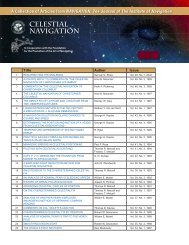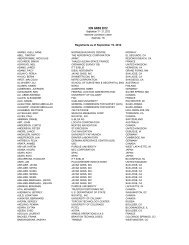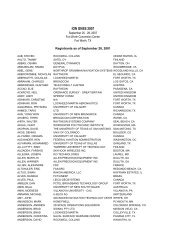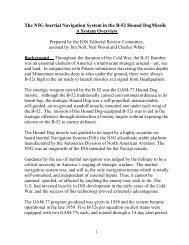Create successful ePaper yourself
Turn your PDF publications into a flip-book with our unique Google optimized e-Paper software.
<strong>UC</strong> <strong>Robomow</strong> <strong>2009</strong><br />
<strong>Technical</strong> <strong>Report</strong><br />
ION Robotic Lawnmower Competition<br />
Beavercreek, Ohio<br />
May 28-30, <strong>2009</strong><br />
University of Cincinnati<br />
College of Engineering<br />
Team Members<br />
Matt Hagedon, Electrical & Computer Engineering Department<br />
Luke Grubbs, Electrical & Computer Engineering Department<br />
James Morris, Electrical & Computer Engineering Department<br />
John Lammers, Electrical & Computer Engineering Department<br />
Advisor<br />
Dr. Howard Fan, Electrical & Computer Engineering Department
Table of Contents<br />
1 Overview……………………………………………………………………. 3<br />
1.1 Team Organization…………………………………………………… 3<br />
Figure 1.1.1 Team Organization<br />
1.2 Lawnmower Design…………………………………………………. 3<br />
Figure 1.2.1 RL850 Design<br />
Figure 1.2.2 RL850 Front View<br />
Figure 1.2.3 RL850 Side View<br />
2 Electronic Design…………………………………………………………… 5<br />
2.1 Main Control Unit……………………………………………………. 5<br />
2.2 Sensors……………………………………………………………….. 5<br />
Figure 2.2.1 Hardware Design Diagram<br />
2.3 Power System………………………………………………………… 6<br />
3 Software Strategy…………………………………………………………… 7<br />
3.1 Overview…………………………………………………………….. 7<br />
Figure 3.1.1 Software Design Diagram<br />
3.2 Vision Algorithm…………………………………………………….. 8<br />
Figure 3.2.1 GUI Image Results<br />
Figure 3.2.2 Lawn Discovery Logic Diagram<br />
Figure 3.2.3 Border Detection Logic Diagram<br />
3.3 Path Planning………………………………………………………… 9<br />
Figure 3.3.1 GUI Path Planning Results<br />
3.4 Kalman Filter………………………………………………………… 10<br />
Figure 3.4.1 Mow Rows Logic Diagram<br />
4 Safety System………………………………………………………………. 12<br />
4.1 Local Emergency Stop………………………………………………. 12<br />
4.2 Remote Emergency Stop…………………………………………….. 12<br />
Figure 4.2.1 Safety System Diagram<br />
5 System Integration………………………………………………………….. 13<br />
Figure 5.1 System Integration Diagram<br />
6 System Specifications………………………………………………………. 14<br />
6.1 Cost…………………………………………………………………... 14<br />
Figure 6.1.1 Summary of Cost<br />
6.2 Dimensions…………………………………………………………... 15<br />
6.3 Cutting Width………………………………………………………... 15<br />
6.4 Mowing Speed………………………………………………………... 15<br />
6.5 Battery Usage…………………………………………………………. 15<br />
7 Patrons……………………………………………………………………….. 16<br />
2
1 Overview<br />
1.1 Team Organization<br />
This is the first year the University of Cincinnati has participated in the ION<br />
Robotic Lawn Mower Competition. Our team consists of four students and one<br />
advisor, all of which have electrical engineering backgrounds. We divided into<br />
two subgroups with one focusing on hardware integration and the other focusing<br />
on software design. After our preliminary design work was complete, the two<br />
subgroups merged, and system level integration and testing was approached as one<br />
team.<br />
Hardware<br />
Integration<br />
John Lammers<br />
James Morris<br />
Software<br />
Design<br />
Matt Hagedon<br />
Luke Grubbs<br />
Figure 1.1.1 The hardware integration and software design subgroups and their members are<br />
depicted above. The two subgroups combined to approach system level integration and testing<br />
as one team.<br />
1.2 Lawnmower Design<br />
We chose to use the Friendly Robotics RL850, a commercially available<br />
autonomous lawnmower, as our team’s lawnmower design due to its strong upside.<br />
The RL850 provides all of the functionality needed to mow a yard, namely<br />
navigation with zero turn radius and blade control, which eliminated the<br />
mechanical design work and allowed our team of electrical engineers to focus on<br />
the electronic design and control logic. Although it was built to operate in<br />
autonomous mode, the RL850 can operate in manual mode, which relies on the<br />
user to provide commands to the mower through a hand held controller. Our<br />
design will use the RL850 in manual mode and replace the user’s input to the<br />
controller with a custom designed control system fixed on the hood of the RL850.<br />
3<br />
System<br />
Test<br />
Matt Hagedon<br />
Luke Grubbs<br />
James Morris<br />
John Lammers
Figure 1.2.1 Preliminary design of the <strong>UC</strong> <strong>Robomow</strong> <strong>2009</strong> robotic lawnmower<br />
Figure 1.2.2 Front view of <strong>UC</strong> <strong>Robomow</strong> <strong>2009</strong> Figure 1.2.3 Back view of <strong>UC</strong> <strong>Robomow</strong> <strong>2009</strong><br />
4
2 Electronic Design<br />
2.1 Main Control Unit<br />
The main control unit consists of a PIC32 micro-controller and a Zotac NF610 IDE<br />
with Core2Duo. The PIC32 is used to send control commands to the RL850 over a<br />
parallel I/O port as well as interface with the digital compass, sonar, and IMU.<br />
The PIC32 interfaces with the digital compass and sonar over an inter-IC (I2C) bus<br />
and the IMU over the universal asynchronous receiver/transmitter (UART).<br />
The PC is used to handle data from the sensors that require heavy data processing,<br />
such as the web cam and GPS. The PC interfaces with both the web cam and GPS<br />
over a universal serial bus (USB).<br />
The PIC32 and PC exchange data over a UART-to-USB converter.<br />
2.2 Sensors<br />
The sensing system consists of a global positioning system (GPS), an inertial<br />
measurement unit (IMU), a digital compass, a sonar unit, and a web cam.<br />
The GPS unit used in our control system is the San Jose Navigation FV-M8, which<br />
supports DGPS operation with up to 2.6m accuracy. We have configured the unit<br />
to operate with an update rate of 5 Hz and a baud rate of 38400Bd. The FV-M8<br />
supply voltage is 3.3-5V, however, we are using an evaluation board that allows us<br />
to both power and communicate with the device via USB.<br />
The IMU used in our control system is the Atomic IMU 6DOF, which is hardwired<br />
to the PIC32 micro controller using a UART interface with an update rate of 1Hz<br />
and baud rate of 200Bd. The IMU achieves six degrees of freedom using a<br />
Freescale MMA7260Q TM triple axis accelerometer with up to 6g sensitivity and<br />
three ST Microelectronics LISY300AL TM single axis 300°/s gyros.<br />
The digital compass used in our control system is the Devantech R117, which<br />
interfaces with the PIC32 micro controller on an I2C bus. The compass offers 0.1°<br />
resolution with up to 3° accuracy at an update rate of 5Hz and a baud rate of<br />
115200Bd.<br />
The GPS, IMU, and digital compass are used to provide position information to the<br />
controller. The lack of accuracy in the sensors is compensated for by integrating<br />
5
the sensors using a Kalman Filter, which will be discussed in more detail in the<br />
Software Strategy section of this report.<br />
The sonar unit used in our control system is the Devantech SRF10 Ranger, which<br />
interfaces with the PIC32 micro controller on the I2C bus at an update rate of 5Hz<br />
and a baud rate of 115200Bd. Ranging is done using a fully timed echo, and<br />
results are reported in millimeters. The sonar’s sole responsibility is to inform the<br />
controller of obstacles in the lawnmower’s path.<br />
The web cam used in our control system is the Logitech QuickCam Pro, which<br />
interfaces with the PC via USB and is capable of capturing thirty frames per<br />
second. The web cam is used to detect and track the white lines surrounding the<br />
perimeter of the mowing area.<br />
Figure 2.2.1 <strong>UC</strong> <strong>Robomow</strong> <strong>2009</strong> hardware design diagram<br />
2.3 Power System<br />
A 24V sealed lead acid (SLA) battery is used to drive the three 150W motors on<br />
the RL850 and all electronic components in our custom control system. The<br />
average charge time is twenty hours while the average operation time per charge is<br />
three hours.<br />
6
3 Software Strategy<br />
3.1 Overview<br />
There were a number of different programming languages used to drive the various<br />
components from a software perspective. The PIC32 was coded in C, the PC in<br />
C#, and many of the algorithms we used were coded in MATLAB. The main<br />
control program is event driven and runs in a C# environment on the PC. The<br />
events driving the mower’s activity are based on the vision algorithm and pathplanning<br />
algorithm used.<br />
Figure 3.1.1 <strong>UC</strong> <strong>Robomow</strong> <strong>2009</strong> software design diagram showing the interaction between<br />
software classes<br />
7
3.2 Vision Algorithm<br />
The vision algorithm uses the Logitech QuickCam Pro to detect and track the white<br />
lines surrounding the mowing area. When the web cam captures a frame, it is sent<br />
to the PC for processing. In order to extract the necessary data from the captured<br />
frame, a Matlab transform and a Hough transform must be implemented. The<br />
MATLAB transform changes the rectangular image into a trapezoidal image in<br />
order to compensate for the angle at which the Logitech QuickCam points towards<br />
the ground, and the Hough transform is used to identify visible lines.<br />
Figure 3.2.1 A screen shot of the graphical user interface (GUI) while debugging video in a<br />
simulation environment. Image results from the Logitech QuickCam Pro (top left), the Hough<br />
transform (bottom left), and the Matlab transform (right) are shown.<br />
Once the lines are detected, the mower will execute an algorithm pertaining to the<br />
state (lawn discovery, border detection, or mow rows) that the lawnmower is in.<br />
The lawn discovery state is used at the start of a mowing session to enter the<br />
mowing area. Once the mower enters the lawn, the border detection state is used<br />
to mow the perimeter of the lawn and log GPS waypoints. After mowing the<br />
8
perimeter of the lawn, the lawnmower switches to the mow rows state and the<br />
path-planning algorithm is invoked.<br />
Figure 3.2.2 Lawn discovery logic diagram<br />
Figure 3.2.3 Basic border detection logic diagram; the advanced border detection algorithm will<br />
implement slight right/left movements if the slope of the line is large<br />
3.3 Path Planning<br />
Path planning is achieved by breaking the mowing area into a grid of 0.5m 2<br />
squares and placing an objective point at the end of the first row of the mowing<br />
area. The A* algorithm is used to develop a dynamic path to each objective point<br />
by assigning scores to the squares surrounding the current square and instructing<br />
the lawnmower to move to the surrounding square with the lowest score. The<br />
score assigned to each square consists of the sum of two terms, one of which biases<br />
the square while the other term is heuristic. A mowed square will receive a higher<br />
9
iasing term than an un-mowed square promoting movement to un-mowed areas of<br />
the lawn. The heuristic term is determined using the Manhattan method, which<br />
estimates the number of moves from the square to the objective point. Any square<br />
that has been identified by the sonar as containing an obstacle will not be assigned<br />
a score, and therefore will not be considered a valid next move in the path planning<br />
algorithm. Once the current objective point is reached, a new objective point is<br />
created at the end of the next row.<br />
Figure 3.3.1 A screen shot of the GUI while debugging path planning. Path planning results<br />
from the A* algorithm using the Manhattan method to determine the heuristic term are shown.<br />
(Lawn Grid – Black, Mower Path – Red, Obstacle – Solid Square)<br />
3.4 Kalman Filter<br />
While the A* algorithm provides robust path plans, it relies on the system’s<br />
sensors to accurately position the robot according to plan. Because the position<br />
sensors used on <strong>UC</strong> <strong>Robomow</strong> <strong>2009</strong> are less accurate than desired, a Kalman Filter<br />
is used to integrate the sensors and improve position accuracy using covariance<br />
matrices. Although the Kalman Filter is the driving force behind the lawnmower<br />
10
when in the mow rows state, there is redundancy built into the design using the<br />
vision algorithm. When in the mow rows state, the vision algorithm runs behind<br />
the Kalman Filter and interrupts operation if a line is detected. Designing the<br />
program with the added redundancy of the vision algorithm prevents the<br />
lawnmower from leaving the mowing area due to poor Kalman Filter results or<br />
inaccurate sensor data.<br />
Figure 3.4.1 Logic diagram of the redundancy check on the Kalman Filter positioning, used to<br />
prevent the mower from heading outside of the mowing area while in the mow rows state<br />
11
4 Safety System<br />
4.1 Local Emergency Stop<br />
The local emergency stop was implemented using a momentary push button switch<br />
in series between the battery and the RL850. When pressed, the switch cuts power<br />
to the RL850 shutting down all movement and blade activity until the button is<br />
released. When power is returned to the RL850, the custom control system will<br />
assume command of the RL850.<br />
4.2 Remote Emergency Stop<br />
The remote emergency stop was implemented using a radio frequency (RF)<br />
receiver and relay placed in series between the battery and the RL850. When the<br />
receiver gets a signal from the remote RF transmitter, the relay cuts power to the<br />
RL850 shutting down all movement and blade activity. When power is returned to<br />
the robot, the custom control system will assume command of the RL850.<br />
+<br />
24V<br />
Battery<br />
-<br />
+<br />
Control<br />
System<br />
-<br />
Push<br />
Button<br />
Relay Relay<br />
Figure 4.2.1 <strong>UC</strong> <strong>Robomow</strong> <strong>2009</strong> safety system diagram<br />
12<br />
RF Rx<br />
RF Link<br />
RF Tx<br />
+<br />
RL850<br />
Mower<br />
-
5 System Integration<br />
System integration requires the combination of the power/safety system, the<br />
control system, and the RL850 lawnmower. The RL850 includes an on board<br />
power system, which was used to pull power to the control system. The power<br />
system interfaces with the control system through an M4-ATX power supply,<br />
which then distributes the required voltages to each component of the control<br />
system. The control system interfaces with the RL850 via a parallel I/O port from<br />
the PIC32 to the RL850 controller.<br />
Figure 5.1 <strong>UC</strong> <strong>Robomow</strong> <strong>2009</strong> system integration diagram<br />
13
6 System Specifications<br />
6.1 Cost<br />
The total cost, including both donated and purchased items, for <strong>UC</strong> <strong>Robomow</strong><br />
<strong>2009</strong> was $3302.60. The cost of donated items was $2140.99 while the cost of<br />
purchased items was $1161.61.<br />
Summary of Costs<br />
Item Description Quantity Cost Total<br />
DONATED ITEMS<br />
Friendly Robotics RL850 1 $1,999.00 $1,999.00<br />
Logitech QuickCam Pro 1 $99.99 $99.99<br />
Linksys Wireless G Broadband Router 1 $42.00 $42.00<br />
Total Cost of Donated Items $2,140.99<br />
PURCHASED ITEMS<br />
Pactec CL-500 Plastic Electronics Enclosure 1 $64.78 $64.78<br />
M4-ATX Power Supply 1 $107.39 $107.39<br />
Intel Pentium E5200, 4GB SDRAM, 3GB HD 1 $163.89 $163.89<br />
Zotac GeForce 7 Motherboard 1 $54.57 $54.57<br />
Microchip PIC32 Starter Kit 1 $63.74 $63.74<br />
Microchip PIC32 Development Board 1 $87.18 $87.18<br />
San Jose Navigation FV-M8 GPS 1 $153.29 $153.29<br />
Atomic IMU - 6DOF V2 1 $188.64 $188.64<br />
IMU Programmer 1 $20.00 $20.00<br />
Devantech R-117 Digital Compass 1 $57.00 $57.00<br />
Devantech SRF10 Ranger 1 $64.00 $64.00<br />
Devantech SRF10 Housing Unit 1 $9.00 $9.00<br />
GWS Standard Servo 1 $10.90 $10.90<br />
Remote Emergency Stop System 1 $16.81 $16.81<br />
USB/Serial Assembly V2.0 1 $29.00 $29.00<br />
USB/Serial TTL converter 1 $36.00 $36.00<br />
Cooling Fan 1 $19.02 $19.02<br />
Miscellaneous 1 $16.40 $16.40<br />
Total Cost of Purchased Items $1,161.61<br />
GRAND TOTALS<br />
Total Cost of Donated and Purchased Items $3,302.60<br />
Figure 6.1.1 A summary of costs for <strong>UC</strong> <strong>Robomow</strong> <strong>2009</strong><br />
14
6.2 Dimensions<br />
The overall dimensions of <strong>UC</strong> <strong>Robomow</strong> <strong>2009</strong> are 37”x26”x 21.5”. The<br />
dimensions of the RL850 are 35”x26”x12.5” while the dimensions of the control<br />
system are 12”x12.5”x6” with a 6.5” camera mount extending off to one side.<br />
6.3 Cutting Width<br />
The cutting width of the lawnmower is 21”.<br />
6.4 Mowing Speed<br />
The mowing speed of the lawnmower is 1.8km/hr or 3.6km/hr depending on the<br />
user’s input.<br />
6.5 Battery Usage<br />
The SLA battery can operate for approximately 3 hours per 20-hour charge<br />
session.<br />
15
7 Patrons<br />
o The University of Cincinnati Robotics Laboratory<br />
o General Electric Company<br />
o Fosdick & Hilmer, Inc.<br />
o Zion Temple First Pentecostal Church<br />
16







